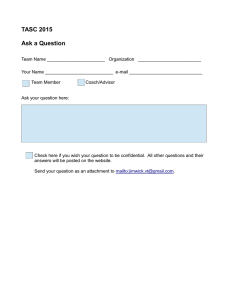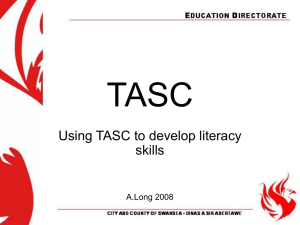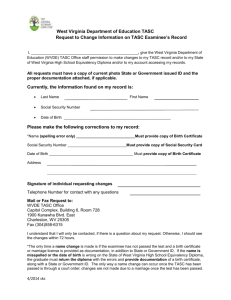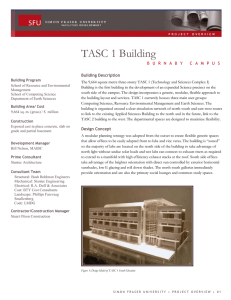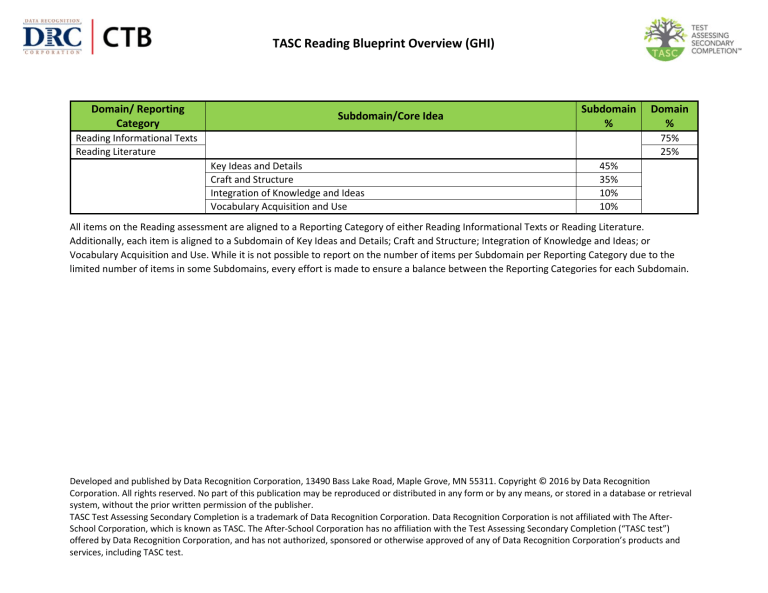
TASC Reading Blueprint Overview (GHI)
Domain/ Reporting
Category
Subdomain/Core Idea
Subdomain
%
Reading Informational Texts
Reading Literature
Domain
%
75%
25%
Key Ideas and Details
Craft and Structure
Integration of Knowledge and Ideas
Vocabulary Acquisition and Use
45%
35%
10%
10%
All items on the Reading assessment are aligned to a Reporting Category of either Reading Informational Texts or Reading Literature.
Additionally, each item is aligned to a Subdomain of Key Ideas and Details; Craft and Structure; Integration of Knowledge and Ideas; or
Vocabulary Acquisition and Use. While it is not possible to report on the number of items per Subdomain per Reporting Category due to the
limited number of items in some Subdomains, every effort is made to ensure a balance between the Reporting Categories for each Subdomain.
Developed and published by Data Recognition Corporation, 13490 Bass Lake Road, Maple Grove, MN 55311. Copyright © 2016 by Data Recognition
Corporation. All rights reserved. No part of this publication may be reproduced or distributed in any form or by any means, or stored in a database or retrieval
system, without the prior written permission of the publisher.
TASC Test Assessing Secondary Completion is a trademark of Data Recognition Corporation. Data Recognition Corporation is not affiliated with The After‐
School Corporation, which is known as TASC. The After‐School Corporation has no affiliation with the Test Assessing Secondary Completion (“TASC test”)
offered by Data Recognition Corporation, and has not authorized, sponsored or otherwise approved of any of Data Recognition Corporation’s products and
services, including TASC test.
TASC Reading Detailed Blueprint (GHI)
Domain/
Reporting
Category
Subdomain/
Core Idea
Anchor Standard
1: Read closely to
determine what the text
says explicitly and to make
logical inferences from it;
cite specific textual
evidence when writing or
speaking to support
conclusions drawn from the
text.
Reading
Informational
Texts
Key Ideas
and Details
Standard/
Performance
Expectation
RI.9‐10.1
RI.9‐10.2
2: Determine central ideas
or themes of a text and
analyze their development;
summarize the key
supporting details and
ideas.
RI.11‐12.2
Standard Description
AE‐CCR
Level
TASC
Emphasis for
Forms GHI
Cite strong and thorough textual
evidence to support analysis of what
the text says explicitly as well as
inferences drawn from the text.
E
High
E
High
E
High
Determine a central idea of a text
and analyze its development over the
course of the text, including how it
emerges and is shaped and refined
by specific details; provide an
objective summary of the text.
Determine two or more central ideas
of a text and analyze their
development over the course of the
text, including how they interact and
build on one another to provide a
complex analysis; provide an
objective summary of the text.
Copyright © 2016 Data Recognition Corporation. All rights reserved. TASC is a trademark of Data Recognition Corporation.
Page 2
TASC Reading Detailed Blueprint (GHI), continued
Domain/
Reporting
Category
Subdomain/
Core Idea
Anchor Standard
Standard/
Performance
Expectation
RI.9‐10.3
Key Ideas
and Details
continued
3: Analyze how and why
individuals, events, and
ideas develop and interact
over the course of a text.
RI.11‐12.3
Reading
Informational
Texts
continued
Craft and
Structure
4: Interpret words and
phrases as they are used in
a text, including
determining technical,
connotative, and figurative
meanings, and analyze how
specific word choices shape
meaning or tone.
RI.9‐10.4
RI.11‐12.4
Standard Description
AE‐CCR
Level
TASC
Emphasis for
Forms GHI
E
High
E
High
E
Medium
E
Medium
Analyze how the author unfolds an
analysis or series of ideas or events,
including the order in which the
points are made, how they are
introduced and developed, and the
connections that are drawn between
them.
Analyze a complex set of ideas or
sequence of events and explain how
specific individuals, ideas, or events
interact and develop over the course
of the text.
Determine the meaning of words and
phrases as they are used in a text,
including figurative, connotative, and
technical meanings; analyze the
cumulative impact of specific word
choices on meaning and tone (e.g.,
how the language of a court opinion
differs from that of a newspaper).
Determine the meaning of words and
phrases as they are used in a text,
including figurative, connotative, and
technical meanings; analyze how an
author uses and refines the meaning
of a key term or terms over the
course of a text (e.g., how Madison
defines faction in Federalist No. 10).
Copyright © 2016 Data Recognition Corporation. All rights reserved. TASC is a trademark of Data Recognition Corporation.
Page 3
TASC Reading Detailed Blueprint (GHI), continued
Domain/
Reporting
Category
Reading
Informational
Texts
continued
Subdomain/
Core Idea
Craft and
Structure
continued
Anchor Standard
5: Analyze the structure of
texts, including how
specific sentences,
paragraphs, and larger
portions of the text (e.g., a
section, chapter, scene, or
stanza) relate to each other
and the whole.
Standard/
Performance
Expectation
RI.9‐10.5
RI 11‐12.5
RI.9‐10.6
6: Assess how point of view
or purpose shapes the
content and style of a text.
RI.11‐12.6
Standard Description
AE‐CCR
Level
TASC
Emphasis for
Forms GHI
E
Medium
E
Medium
E
Medium
E
Medium
Analyze in detail how an author’s
ideas or claims are developed and
refined by particular sentences,
paragraphs, or larger portions of a
text (e.g., a section or chapter).
Analyze and evaluate the
effectiveness of the structure an
author uses in his or her exposition or
argument, including whether the
structure makes points clear,
convincing, and engaging.
Determine an author’s point of view
or purpose in a text and analyze how
an author uses rhetoric to advance
that point of view or purpose.
Determine an author’s point of view
or purpose in a text in which the
rhetoric is particularly effective,
analyzing how style and content
contribute to the power,
persuasiveness, or beauty of the text.
Copyright © 2016 Data Recognition Corporation. All rights reserved. TASC is a trademark of Data Recognition Corporation.
Page 4
TASC Reading Detailed Blueprint (GHI), continued
Domain/
Reporting
Category
Subdomain/
Core Idea
Anchor Standard
7: Integrate and evaluate
content presented in
diverse formats and media,
including visually and
quantitatively, as well as in
words.
Reading
Informational
Texts
continued
Integration
of
Knowledge
and Ideas
Standard/
Performance
Expectation
RI.11‐12.7
RI.9‐10.8
8: Delineate and evaluate
the argument and specific
claims in a text, including
the validity of the
reasoning as well as the
relevance and sufficiency of
the evidence.
RI.11‐12.8
Standard Description
AE‐CCR
Level
TASC
Emphasis for
Forms GHI
E
Low
E
Low
E
Low
Integrate and evaluate multiple
sources of information presented in
different media or formats (e.g.,
visually, quantitatively) as well as in
words in order to address a question
or solve a problem.
Delineate and evaluate the argument
and specific claims in a text, assessing
whether the reasoning is valid and
the evidence is relevant and
sufficient; identify false statements
and fallacious reasoning.
Delineate and evaluate the reasoning
in seminal U.S. texts, including the
application of constitutional
principles and use of legal reasoning
(e.g., in U.S. Supreme Court majority
opinions and dissents) and the
premises, purposes, and arguments
in works of public advocacy (e.g., The
Federalist, presidential addresses).
Copyright © 2016 Data Recognition Corporation. All rights reserved. TASC is a trademark of Data Recognition Corporation.
Page 5
TASC Reading Detailed Blueprint (GHI), continued
Domain/
Reporting
Category
Subdomain/
Core Idea
Anchor Standard
Standard/
Performance
Expectation
AE‐CCR
Level
TASC
Emphasis for
Forms GHI
E
Low
E
Low
RI‐LA.11‐12.4
Determine or clarify the meaning of
unknown and multiple‐meaning
words and phrases based on grades
11–12 reading and content, choosing
flexibly from a range of strategies.
E
Medium
RI‐LA.11‐12.5
Demonstrate understanding of
figurative language, word
relationships, and nuances in word
meanings.
E
Low
RI.9‐10.9
Integration
of
Knowledge
and Ideas
continued
9: Analyze how two or
more texts address similar
themes or topics in order
to build knowledge or to
compare the approaches
the authors take.
RI.11‐12.9
Reading
Informational
Texts
continued
Vocabulary
Acquisition
and Use
4: Determine or clarify the
meaning of unknown and
multiple‐meaning words
and phrases by using
context clues, analyzing
meaningful word parts,
and consulting general and
specialized reference
materials, as appropriate.
5: Demonstrate
understanding of figurative
language, word
relationships, and nuances
in word meanings.
Standard Description
Analyze seminal U.S. documents of
historical and literary significance
(e.g., Washington’s Farewell
Address, the Gettysburg Address,
Roosevelt’s Four Freedoms speech,
King’s “Letter from Birmingham
Jail”), including how they address
related themes and concepts.
Analyze seventeenth‐, eighteenth‐,
and nineteenth‐century foundational
U.S. documents of historical and
literary significance (including The
Declaration of Independence, the
Preamble to the Constitution, the Bill
of Rights, and Lincoln’s Second
Inaugural Address) for their themes,
purposes, and rhetorical features.
Copyright © 2016 Data Recognition Corporation. All rights reserved. TASC is a trademark of Data Recognition Corporation.
Page 6
TASC Reading Detailed Blueprint (GHI), continued
Domain/
Reporting
Category
Subdomain/
Core Idea
Anchor Standard
1: Read closely to
determine what the text
says explicitly and to make
logical inferences from it;
cite specific textual
evidence when writing or
speaking to support
conclusions drawn from
the text.
Reading
Literature
Standard/
Performance
Expectation
RL.9‐10.1
RL.11‐12.1
Key Ideas
and Details
RL.9‐10.2
2: Determine central ideas
or themes of a text and
analyze their development;
summarize the key
supporting details and
ideas.
RL.11‐12.2
Standard Description
Cite strong and thorough textual
evidence to support analysis of what
the text says explicitly as well as
inferences drawn from the text.
Cite strong and thorough textual
evidence to support analysis of what
the text says explicit as well as
inferences drawn from the text,
including determining where the text
leaves matters uncertain.
Determine a theme or central idea of
a text and analyze in detail its
development over the course of the
text, including how it emerges and is
shaped and refined by specific
details; provide an objective
summary of the text.
Determine two or more themes or
central ideas of a text and analyze
their development over the course
of the text, including how they
interact and build on one another to
produce a complex account; provide
an objective summary of the text.
AE‐CCR
Level
TASC
Emphasis for
Forms GHI
E
Medium
Not
Included
Medium
E
Medium
Not
Included
Medium
Copyright © 2016 Data Recognition Corporation. All rights reserved. TASC is a trademark of Data Recognition Corporation.
Page 7
TASC Reading Detailed Blueprint (GHI), continued
Domain/
Reporting
Category
Subdomain/
Core Idea
Anchor Standard
Standard/
Performance
Expectation
RL.9‐10.3
Key Ideas
and Details
continued
3: Analyze how and why
individuals, events, and
ideas develop and
interact over the course
of a text.
RL.11‐12.3
Reading
Literature
continued
RL.9‐10.4
Craft and
Structure
4: Interpret words and
phrases as they are used
in a text, including
determining technical,
connotative, and
figurative meanings, and
analyze how specific
word choices shape
meaning or tone.
RL.11‐12.4
Standard Description
AE‐CCR
Level
TASC
Emphasis for
Forms GHI
E
Medium
E
Medium
E
Medium
E
Medium
Analyze how complex characters (e.g.,
those with multiple or conflicting
motivations) develop over the course
of a text, interact with other
characters, and advance the plot or
develop the theme.
Analyze the impact of the author’s
choices regarding how to develop and
relate elements of a story or drama
(e.g., where a story is set, how the
action is ordered, how the characters
are introduced and developed).
Determine the meaning of words and
phrases as they are used in the text,
including figurative and connotative
meanings; analyze the cumulative
impact of specific word choices on
meaning and tone (e.g., how the
language evokes a sense of time and
place; how it sets a formal or informal
tone).
Determine the meaning of words and
phrases as they are used in the text,
including figurative and connotative
meanings; analyze the impact of
specific word choices on meaning and
tone, including words with multiple
meanings or language that is
particularly fresh, engaging, or
beautiful. (Include Shakespeare as well
as other authors.)
Copyright © 2016 Data Recognition Corporation. All rights reserved. TASC is a trademark of Data Recognition Corporation.
Page 8
TASC Reading Detailed Blueprint (GHI), continued
Domain/
Reporting
Category
Subdomain/
Core Idea
Craft and
Structure
continued
Anchor Standard
5: Analyze the structure of
texts, including how
specific sentences,
paragraphs, and larger
portions of the text (e.g., a
section, chapter, scene, or
stanza) relate to each
other and the whole.
Standard/
Performance
Expectation
RL.9‐10.5
RL.11‐12.5
Reading
Literature
continued
RL.9‐10.6
6: Assess how point of view
or purpose shapes the
content and style of a text.
RL.11‐12.6
Integration
of
Knowledge
and Ideas
9: Analyze how two or
more texts address similar
themes or topics in order
to build knowledge or to
compare the approaches
the authors take.
RL.9‐10.9
Standard Description
Analyze how an author’s choices
concerning how to structure a text,
order events within it (e.g., parallel
plots), and manipulate time (e.g.,
pacing, flashbacks) create such
effects as mystery, tension, or
surprise.
Analyze how an author’s choices
concerning how to structure specific
parts of a text (e.g., the choice of
where to begin or end a story, the
choice to provide a comedic or tragic
resolution) contribute to its overall
structure and meaning as well as its
aesthetic impact.
Analyze a particular point of view or
cultural experience reflected in a
work of literature from outside the
United States, drawing on a wide
reading of world literature.
Analyze a case in which grasping
point of view requires distinguishing
what is directly stated in a text from
what is really meant (e.g., satire,
sarcasm, irony, or understatement).
Analyze how an author draws on and
transforms source material in a
specific work (e.g., how Shakespeare
treats a theme or topic from Ovid or
the Bible or how a later author draws
on a play by Shakespeare).
AE‐CCR
Level
TASC
Emphasis for
Forms GHI
E
Low
E
Low
E
Low
E
Low
Not
included
Low
Copyright © 2016 Data Recognition Corporation. All rights reserved. TASC is a trademark of Data Recognition Corporation.
Page 9
TASC Reading Detailed Blueprint (GHI), continued
Domain/
Reporting
Category
Reading
Literature
continued
Subdomain/
Core Idea
Anchor Standard
Vocabulary
Acquisition
and Use
4: Determine or clarify the
meaning of unknown and
multiple‐meaning words
and phrases by using
context clues, analyzing
meaningful word parts,
and consulting general and
specialized reference
materials, as appropriate.
5: Demonstrate
understanding of figurative
language, word
relationships, and nuances
in word meanings.
Standard/
Performance
Expectation
Standard Description
AE‐CCR
Level
TASC
Emphasis for
Forms GHI
RL‐LA.11‐
12.4
Determine or clarify the meaning of
unknown and multiple‐meaning
words and phrases based on grades
11–12 reading and content, choosing
flexibly from a range of strategies.
E
Medium
RL‐LA.11‐
12.5
Demonstrate understanding of
figurative language, word
relationships, and nuances in word
meanings.
E
Low
Copyright © 2016 Data Recognition Corporation. All rights reserved. TASC is a trademark of Data Recognition Corporation.
Page 10

